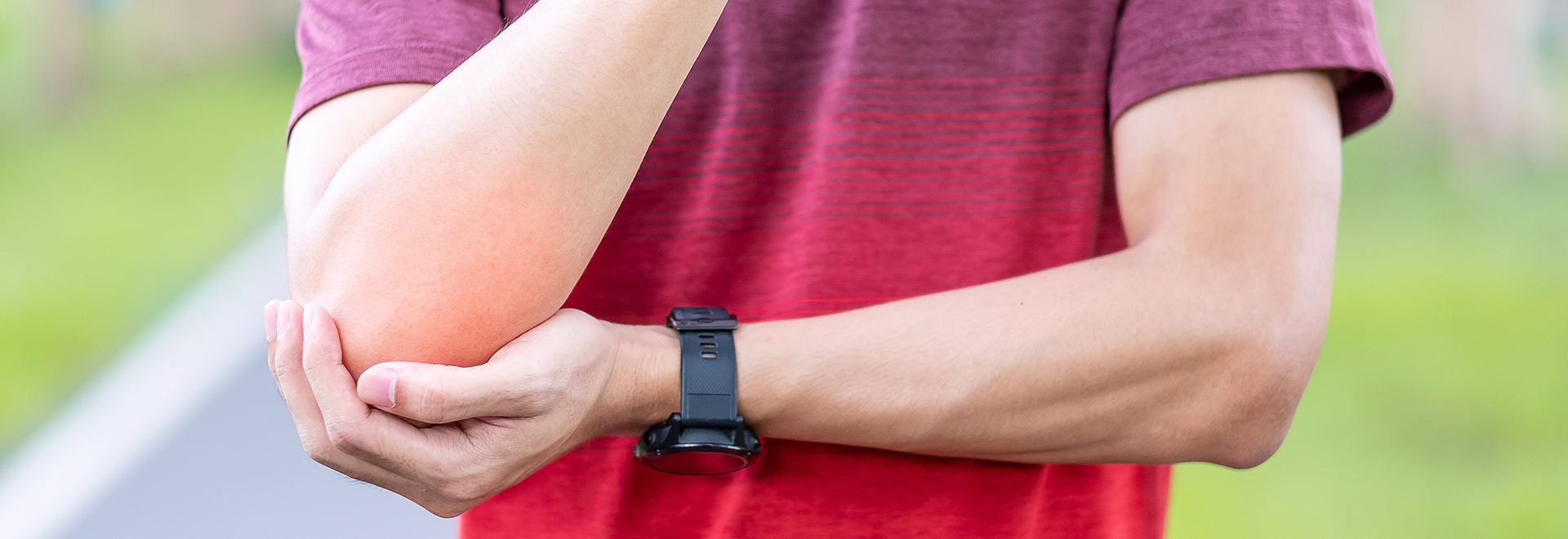Even if you’ve never played a set of tennis or a round of golf, you can still suffer from tennis elbow or golfer’s elbow. Tennis elbow and golfer’s elbow are both overuse injuries caused by repetitive motion of the arm and wrist, leading to inflammation of tendons that attach to the elbow.
Apart from athletes, many city dwellers also suffer from these muscle strains due to repetitive tasks in daily life, such as bad postures while typing at work, repeated heavy lifting or doing housework. All these everyday tasks may contribute to elbow strains, of which tennis elbow and golfer’s elbow are the most common examples.
Tennis Elbow VS Golfer's Elbow
Both tennis elbow and golfer’s elbow are overuse injuries resulting from repetitive motion involving the tendons in your elbow. The difference lies in the location of the inflammation.
|
Conditions |
Injury Location |
Affected Tendons |
Causes |
|
Tennis Elbow Also known as Lateral Epicondylitis |
Outside of elbow |
Common extensor muscles of the wrist |
Repeated forearm movement, such as typing, using a mouse cursor, heavy lifting, holding a baby, doing housework, wrong posture at weight training, playing tennis etc. |
|
Golfer’s Elbow Also known as Medial Epicondylitis |
Inside of elbow |
Flexor muscles of the wrist |
Repeated movements of fingers and bending the wrist, such as lifting, throwing, hitting, lifting heavy objects |
Symptoms of Tennis Elbow & Golfer's Elbow
The major symptom of tennis elbow and golfer’s elbow is the tenderness and pain spreading down the arm, leading to weak grip strength.
Below are the symptoms of tennis elbow and golfer’s elbow:
|
Conditions |
Symptoms |
|
Tennis Elbow |
|
|
Golfer’s Elbow |
|
Simple Self-Tests for Tennis Elbow or Golfer’s Elbow
After understanding their differences, you could determine whether you have a tennis elbow or a golfer’s elbow by freely moving your forearm and wrist.
- Tennis elbow: Extend your affected arm straight out in front of you with your palm facing down. Place your opposite hand on the back of your extended hand. Press your top hand into your bottom hand and attempt to bend the bottom wrist backwards. If you experience pain on the outside of the elbow, you may have a tennis elbow.
- Golfer’s elbow: Bend your elbow with your palm facing up, make a fist and bend your wrist towards yourself. If you have a golfer’s elbow, you may feel pain on the inside of the elbow.
Treatments of Tennis Elbow and Golfer’s Elbow
Depending on the condition of your tennis elbow and golfer’s elbow, your doctor may recommend the following treatments:
Medications
Relieve pain, inflammation and swelling with non-steroidal, anti-inflammatory and pain-killing medicines.
Physiotherapy
A physiotherapist uses ice therapy, manual therapy, ultrasound therapy, extracorporeal shock wave therapy (ESWT) and interferential current therapy (IFC) to relieve pain and inflammation, foster tissue repair and promote healing.
Movement Therapy
Conducted by a physiotherapist or sports therapist, suitable stretches and strengthening exercises for the elbow are suggested to improve the tendon’s power and flexibility.
Posture Adjustment
Apart from professional athletes, most elbow strain cases are caused by bad postures when doing repetitive tasks like typing, using a mouse cursor, and moving heavy objects. Adjusting postures could avoid overusing and strain to relieve ache.
Rest
Take more rest and allow the arm to do fewer activities to avoid motions triggering the pain.
Besides, some may treat the strain by acupuncture, massages or cupping therapy to improve the flexibility and mobility of their muscle fasciae while correcting the position of the elbow at the same time.
How to Prevent Tennis Elbow or Golfer’s Elbow
Unless you are a professional athlete, most of the causes of tennis and golfer’s elbows relate to your habits and daily life. Making some modifications to your usual exercise or work routines can spare you from potential tendon damage. Practising preventive measures can also help prevent a recurrence of elbow injuries due to falling back into old habits.
1. Improve your working environment
If you have a desk job, adjust your chair and computer so your forearms are parallel to the desk or table and your feet are flat on the floor. The adjustment can lower your risk of an elbow strain.
2. Reduce repetitive tasks
Avoid repeatedly using or overusing your forearm and wrist. Take some rest at intervals.
3. Make good use of your full-body strength
Avoid merely relying on your forearm in completing weight-lifting activities, for example, using the power of your legs and waist to drive your arms and shoulders while lifting heavy objects, to prevent an elbow strain.
4. Always warm up before exercises
Always warm up before engaging in physical activities. Be sure to properly stretch and get your blood flowing before playing a sport that involves repetitive arm movements like tennis or squash. For lifting, this could mean starting your sessions with some lighter reps until you feel warm enough to start lifting heavier.
5. Wear elbow splints
If you feel pain in your elbow, you should wear elbow splints to avoid stretching the tendon again.
If you feel discomfort at your elbow, you should visit your doctor or therapist for advice as soon as possible. Delayed diagnosis and consultation may result in prolonged pain and treatment.
Treat yourself better by healing your chronic muscle and tendon strain! Cigna DIY Health Plan enables you to freely choose from various protection benefits to customise your plan to your individual needs, including dental coverage, regular oral check-up, treatment cost and emergency. Tailor your health coverage now.


